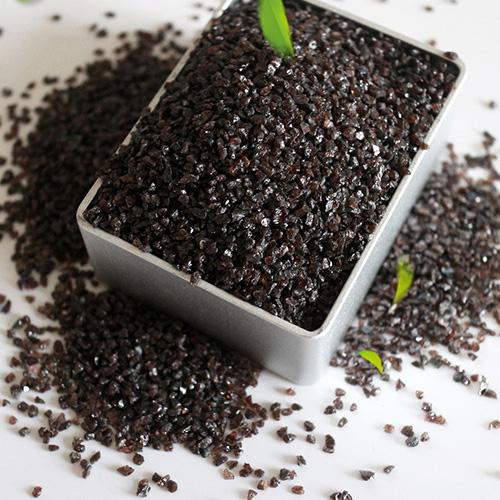
Brown Fused Alumia powders are fused wIth premium raw materials and 3500 KVA furnace. It is perfect material specifically manufactured to be used for general abrasive applications in bonded abrasive tools, polishing and sandblasting grit. It has lower hardness and abrasive capacity than diamond, boron carbide, and silicon carbide, it is widely used for grinding ferrous materials, finishing tough and hard materials. It is also be used as high-class refractory materials. Brown Fused Alumia is offered in macro and micro powder form, in both F and P grades.
Brown fused alumina for refractory
brown corundum is called industrial teeth: mainly used in refractory raw materials, grinding wheels, sand blasting.
Sandblasted brown corundum – sandblasted abrasive with moderate hardness, high bulk density, no free silica, large specific gravity and good toughness. It is an ideal “environmentally friendly” sandblasting material widely used in aluminum profiles and copper profiles. Washed denim clothing precision molds and other fields;
Free grinding - grinding grade abrasives, used in the fields of picture tube, optical glass, monocrystalline silicon, lens, glass for clocks, crystal glass, jade and other fields, is a high-grade abrasive material commonly used in China;
Resin Abrasives—Abrasives have suitable color, good hardness, toughness, suitable particle cross-section type and edge retention. They are used in resin abrasives with good results.
Coated abrasives—abrasives are raw materials for the production of sandpaper, gauze, etc.
Brown corundum functional filler - mainly used for automobile brake parts, special tires, special construction products, etc. It can be used as a wear-resistant material for highway pavement, airstrip, dock, parking lot, industrial floor, sports ground, etc.
Filter media – it is a new application field of abrasives. It uses granular abrasive as the bottom media of filter bed to purify drinking water or waste water. It is a new type of water filtration material at home and abroad, especially suitable for non-ferrous metal beneficiation and oil drilling mud weighting agent.
Brown Fused Alumina for Abrasive:
|
Purpose |
Specification |
Chemical composition(%) |
Magnetic material ≤ |
||||
|
Al2O3(≥) |
Fe2O3(≤) |
SiO2≤ |
TiO2≤ |
||||
|
For abrasive |
F grit |
4#-80# |
95.0 |
0.3 |
1.5 |
3.0 |
0.05 |
|
|
90#-150# |
94.0 |
0.03 |
||||
|
|
180#-240# |
93.0 |
3.5 |
0.02 |
|||
|
P grit |
8#-80# |
95.0 |
0.2 |
1.2 |
3.0 |
0.05 |
|
|
|
100#-150# |
94.0 |
0.03 |
||||
|
|
180#-220# |
93.0 |
0.3 |
1.5 |
3.5 |
0.02 |
|
|
Micro Powder |
W0.5-W63 |
92.5 |
0.5 |
1.8 |
4.0 |
|
|
Brown Fused Alumina for Refractory:
|
Size for Sand |
0-1mm;1-3mm |
95.5 |
0.3 |
1.5 (1.0 from Tilting Furnace) |
3.0 |
|
Size for Sand |
0-3mm;0-5mm |
95.0 |
0.3 |
1.5 |
3.0 |
|
Fine powder |
140F;200F |
94.5 |
0.5 |
1.5 |
3.5 |

Packing : 1). 25 kgs/ bag ,in bulk ;
2). 25 kgs/ bag *40 bags in big bag ;
3). 25 kgs/ bag *40 bags on wooden pallet .
4).According to customer's requirement .
Shipping date : In 20-25 days after receiving your down payment .
White corundum is made from industrial alumina powder, which is smelted in an arc at a high temperature above 2000 ℃ and then cooled. After crushing and shaping, magnetic separation to remove iron, it is divided into various particle sizes.
Brown corundum is made of natural bauxite as raw material, carbon (mainly coke) is used as reducing agent, and iron filings are added as sedimentation agent (clarifier) to form ferrosilicon deposited on the bottom of electric furnace.
Refractory ramming mass (refractory taphole mass) is a kind of Refractory used for lining of blast furnace tapping groove. It is mainly used to protect the blast furnace out of the ditch from high-temperature hot metal and slag erosion and erosion, and has excellent high-temperature resistance and wear resistance. The ramming material for the iron discharge ditch is usually composed of corundum, silicon carbide and carbonaceous material, which has the ability of resisting hot metal and molten slag erosion and scouring, reburning line change small, strong resistance to a variety of oxidation characteristics. The construction of the ramming material for the iron ditch is convenient, easy to dismantle and repair, does not produce harmful gas, and is beneficial to environmental protection.
White corundum is made from industrial alumina powder, which is smelted in an arc at a high temperature above 2000 ℃ and then cooled. After crushing and shaping, magnetic separation to remove iron, it is divided into various particle sizes.
The Al2O3 content of clay heat Clay insulating refractory bricks is generally more than 40%, and the Fe2O3 content is less than 2.0-2.5%. The clinker in the ingredients is 65-85%, and the combined clay is 35-15%. The crushed bonded clay and the finely ground clinker are mixed and milled, and then mixed with the granular clinker to make semi-dry mud, high pressure molding, and sintering at about 1400 ℃, with good performance.
The high-alumina refractory bricks sold by Yuying refractory manufacturers are commonly used refractory bricks with high thermal stability and refractoriness above 1770°C. It has good slag resistance and is used for the lining of steelmaking electric furnaces, glass melting furnaces, cement rotary furnaces, etc.
High alumina brick is one of the indispensable basic refractory materials in the upper and middle parts of blast furnace body in iron and steel industry
In the blast furnace smelting process, blast furnace taphole clay, as a key plastic material, plays a vital role. This article will introduce in detail the product characteristics, working principle and innovation of blast furnace taphole clay in improving furnace stability and production efficiency.
White corundum is made from industrial alumina powder, which is smelted in an arc at a high temperature above 2000 ℃ and then cooled. After crushing and shaping, magnetic separation to remove iron, it is divided into various particle sizes.
Brown corundum is made of natural bauxite as raw material, carbon (mainly coke) is used as reducing agent, and iron filings are added as sedimentation agent (clarifier) to form ferrosilicon deposited on the bottom of electric furnace.
Refractory ramming mass (refractory taphole mass) is a kind of Refractory used for lining of blast furnace tapping groove. It is mainly used to protect the blast furnace out of the ditch from high-temperature hot metal and slag erosion and erosion, and has excellent high-temperature resistance and wear resistance. The ramming material for the iron discharge ditch is usually composed of corundum, silicon carbide and carbonaceous material, which has the ability of resisting hot metal and molten slag erosion and scouring, reburning line change small, strong resistance to a variety of oxidation characteristics. The construction of the ramming material for the iron ditch is convenient, easy to dismantle and repair, does not produce harmful gas, and is beneficial to environmental protection.
White corundum is made from industrial alumina powder, which is smelted in an arc at a high temperature above 2000 ℃ and then cooled. After crushing and shaping, magnetic separation to remove iron, it is divided into various particle sizes.
The Al2O3 content of clay heat Clay insulating refractory bricks is generally more than 40%, and the Fe2O3 content is less than 2.0-2.5%. The clinker in the ingredients is 65-85%, and the combined clay is 35-15%. The crushed bonded clay and the finely ground clinker are mixed and milled, and then mixed with the granular clinker to make semi-dry mud, high pressure molding, and sintering at about 1400 ℃, with good performance.
The high-alumina refractory bricks sold by Yuying refractory manufacturers are commonly used refractory bricks with high thermal stability and refractoriness above 1770°C. It has good slag resistance and is used for the lining of steelmaking electric furnaces, glass melting furnaces, cement rotary furnaces, etc.
High alumina brick is one of the indispensable basic refractory materials in the upper and middle parts of blast furnace body in iron and steel industry
In the blast furnace smelting process, blast furnace taphole clay, as a key plastic material, plays a vital role. This article will introduce in detail the product characteristics, working principle and innovation of blast furnace taphole clay in improving furnace stability and production efficiency.
White corundum is made from industrial alumina powder, which is smelted in an arc at a high temperature above 2000 ℃ and then cooled. After crushing and shaping, magnetic separation to remove iron, it is divided into various particle sizes.
Brown corundum is made of natural bauxite as raw material, carbon (mainly coke) is used as reducing agent, and iron filings are added as sedimentation agent (clarifier) to form ferrosilicon deposited on the bottom of electric furnace.
Refractory ramming mass (refractory taphole mass) is a kind of Refractory used for lining of blast furnace tapping groove. It is mainly used to protect the blast furnace out of the ditch from high-temperature hot metal and slag erosion and erosion, and has excellent high-temperature resistance and wear resistance. The ramming material for the iron discharge ditch is usually composed of corundum, silicon carbide and carbonaceous material, which has the ability of resisting hot metal and molten slag erosion and scouring, reburning line change small, strong resistance to a variety of oxidation characteristics. The construction of the ramming material for the iron ditch is convenient, easy to dismantle and repair, does not produce harmful gas, and is beneficial to environmental protection.
White corundum is made from industrial alumina powder, which is smelted in an arc at a high temperature above 2000 ℃ and then cooled. After crushing and shaping, magnetic separation to remove iron, it is divided into various particle sizes.
The Al2O3 content of clay heat Clay insulating refractory bricks is generally more than 40%, and the Fe2O3 content is less than 2.0-2.5%. The clinker in the ingredients is 65-85%, and the combined clay is 35-15%. The crushed bonded clay and the finely ground clinker are mixed and milled, and then mixed with the granular clinker to make semi-dry mud, high pressure molding, and sintering at about 1400 ℃, with good performance.
The high-alumina refractory bricks sold by Yuying refractory manufacturers are commonly used refractory bricks with high thermal stability and refractoriness above 1770°C. It has good slag resistance and is used for the lining of steelmaking electric furnaces, glass melting furnaces, cement rotary furnaces, etc.
High alumina brick is one of the indispensable basic refractory materials in the upper and middle parts of blast furnace body in iron and steel industry
In the blast furnace smelting process, blast furnace taphole clay, as a key plastic material, plays a vital role. This article will introduce in detail the product characteristics, working principle and innovation of blast furnace taphole clay in improving furnace stability and production efficiency.



